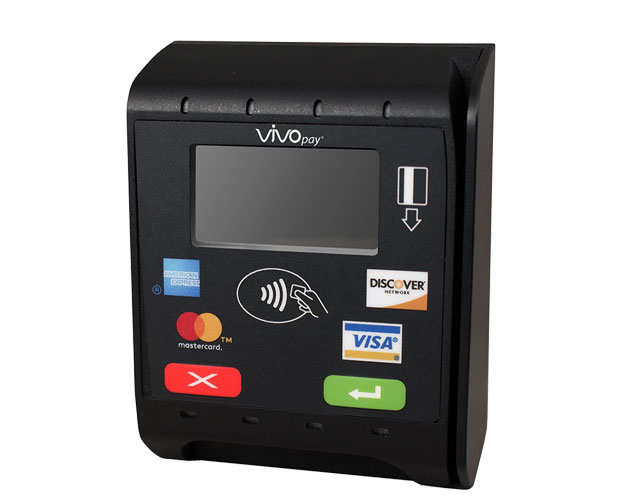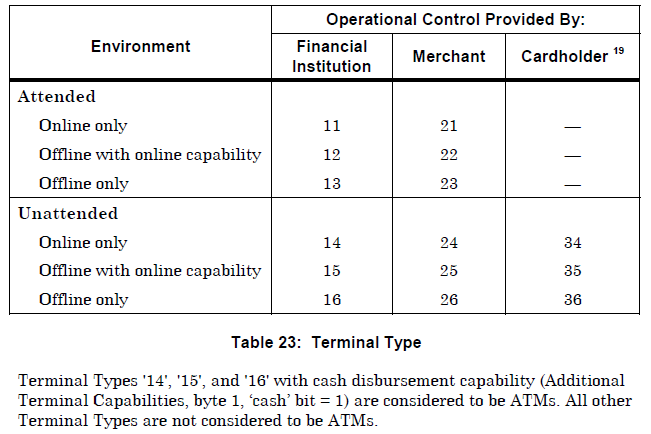Understanding Terminal Types
 When selecting a card reader, or before starting a Level 3 EMV certification, it’s important to know what kind of EMV terminal you will be supporting. The EMV Specs define fifteen different terminal types, depending on whether the payment environment is attended (such as in traditional retail) or unattended (e.g., a self-service kiosk), and whether the terminal goes online or stays offline, plus other factors. The terminal types defined by EMV are shown in the table below, which is taken from Annex A of EMV Book 4:
When selecting a card reader, or before starting a Level 3 EMV certification, it’s important to know what kind of EMV terminal you will be supporting. The EMV Specs define fifteen different terminal types, depending on whether the payment environment is attended (such as in traditional retail) or unattended (e.g., a self-service kiosk), and whether the terminal goes online or stays offline, plus other factors. The terminal types defined by EMV are shown in the table below, which is taken from Annex A of EMV Book 4:

ID TECH offers a wide variety of EMV-ready card readers, but not all of them fit into all of the categories defined above. ID TECH’s current offerings are certified in 5 categories (which we often refer to as 1C, 2C, 3C, 4C, and 5C). The mapping of ID TECH categories to EMV-defined terminal types is shown in greater detail below.
| Terminal Capabilities |
1C |
2C |
3C |
4C |
5C |
Major/ Minor |
| Card Data Input Capability | ||||||
| Terminal Type |
22 |
21 |
25 |
25 |
21 |
|
| Manual Key Entry |
Yes |
No |
No |
No |
No |
Minor |
| Magnetic Stripe |
Yes |
Yes |
Yes |
Yes |
Yes |
Minor |
| IC with Contacts |
Yes |
Yes |
Yes |
Yes |
Yes |
N/A |
| CVM Capability | ||||||
| Plaintext PIN |
Yes |
No |
Yes |
No |
No |
Major |
| Online Enciphered PIN |
Yes |
No |
Yes |
No |
No |
Major |
| Signature (Paper) |
Yes |
Yes |
No |
No |
Yes |
Major |
| Offline Enciphered PIN |
Yes |
No |
Yes |
No |
No |
Major |
| No CVM |
Yes |
Yes |
Yes |
Yes |
Yes |
Major |
Note: CVM stands for Cardholder Verification Method. “No CVM” means the reader supports EMV-defined “No CVM” scenarios, but usually the same reader does, in fact, also support other CVM scenarios, such as chip-and-signature, or chip-and-PIN.
Many ID TECH readers are 3-in-1 readers, able to handle magstripe, contact EMV, and contactless EMV. Readers that are meant to be used in unattended scenarios (self-service kiosks, for example) have Configurations 3C or 4C. (The difference being, 3C can accommodate Chip and PIN, whereas 4C does not allow PIN.) Some ID TECH products, such as the VP8800, are designed to handle “manual key entry” (in addition to magstripe and ICC), which means Card Not Present (Mail-Order/Phone-Order) transactions; these readers utilize what we call Configuration 1C.
The above table is actually a shortened version of a much larger table. The full table can be viewed here.
Once you know which Configuration Type you’ll need to support, you can specify various “terminal settings” for things like Terminal Country Code (tag 9F1A) and Transaction Currency Exponent (5F36), which are considered “Minor Settings” (see the far right hand column?), meaning you can change them at will, without affecting the reader’s certification status. Certain other settings, such as Terminal Type (tag 9F35), are considered “Major Settings,” which means you should not attempt to change their values, because they affect EMV L2 certification status. Any settings you need to change can be changed using ID TECH’s UDemo tool, or (programmatically) using API calls available in the Universal SDK. (If you accidentally attempt to change a Major Setting, you’ll get an error.)
An in-depth discussion of terminal settings is beyond the scope of this post (maybe it’ll get its own post?), but suffice it to say, configuring a card reader’s terminal settings is the starting point for beginning any Level 3 EMV certification project. (After that, you need to load all of the AIDs you intend your reader to support, and all of the public keys, or CAPKs, you need to support.)
Have questions about terminal types? Need help with configuration? Not sure which type of card reader is best for your needs? Talk to one of our in-house experts! Get in touch with us at 1-800-984-1010. We’d love to hear from you.
